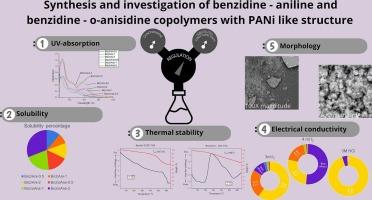类聚苯胺结构的联苯胺-苯胺和联苯胺-邻苯胺共聚物的合成与研究
IF 6.3
2区 化学
Q1 POLYMER SCIENCE
引用次数: 0
摘要
用过硫酸铵在有机介质中进行了苯胺和邻苯胺的氧化聚合反应。通过质子磁共振(PMR)光谱分析所得共聚物的组成,初始联苯胺与邻苯胺的摩尔比分别为1:0.5、1:1和1:2。研究表明,共聚物的物理化学性质,包括紫外-可见(UV-Vis)吸收特性、溶解度、热稳定性、电导率和形态,可以通过调节醌二亚胺与聚苯胺(PANi)类链中取代结构单元的比例来调节。共聚物表现出很高的热稳定性,在600°C下保持其重量的66 - 72%。当掺杂盐酸(HCl)时,它们的电导率与母体均聚物聚苯胺和聚苯胺相当。这些发现表明,结构调制可以提高聚苯胺基共聚物在先进材料中的功能性能。本文章由计算机程序翻译,如有差异,请以英文原文为准。

Synthesis and investigation of benzidine − aniline and benzidine − o-anisidine copolymers with PANi like structure
Copolymerization of benzidine with aniline and o-anisidine was performed via oxidative polymerization using ammonium persulfate in an organic medium. The composition of the resulting copolymers was analyzed by proton magnetic resonance (PMR) spectroscopy for initial benzidine-to-o-anisidine molar ratios of 1:0.5, 1:1, and 1:2. The study demonstrates that the physicochemical properties of the copolymers—including ultraviolet–visible (UV–Vis) absorption characteristics, solubility, thermal stability, electrical conductivity, and morphology—can be tuned by adjusting the ratio of quinonediimine to substituted structural units within the polyaniline (PANi)-like chains. The copolymers exhibited high thermal stability, retaining 66–72 % of their weight up to 600 °C. When doped with hydrochloric acid (HCl), their electrical conductivity was comparable to that of the parent homopolymers, polyaniline and polyanisidine. These findings suggest the potential of structural modulation to enhance the functional performance of PANi-based copolymers for advanced materials applications.
求助全文
通过发布文献求助,成功后即可免费获取论文全文。
去求助
来源期刊

European Polymer Journal
化学-高分子科学
CiteScore
9.90
自引率
10.00%
发文量
691
审稿时长
23 days
期刊介绍:
European Polymer Journal is dedicated to publishing work on fundamental and applied polymer chemistry and macromolecular materials. The journal covers all aspects of polymer synthesis, including polymerization mechanisms and chemical functional transformations, with a focus on novel polymers and the relationships between molecular structure and polymer properties. In addition, we welcome submissions on bio-based or renewable polymers, stimuli-responsive systems and polymer bio-hybrids. European Polymer Journal also publishes research on the biomedical application of polymers, including drug delivery and regenerative medicine. The main scope is covered but not limited to the following core research areas:
Polymer synthesis and functionalization
• Novel synthetic routes for polymerization, functional modification, controlled/living polymerization and precision polymers.
Stimuli-responsive polymers
• Including shape memory and self-healing polymers.
Supramolecular polymers and self-assembly
• Molecular recognition and higher order polymer structures.
Renewable and sustainable polymers
• Bio-based, biodegradable and anti-microbial polymers and polymeric bio-nanocomposites.
Polymers at interfaces and surfaces
• Chemistry and engineering of surfaces with biological relevance, including patterning, antifouling polymers and polymers for membrane applications.
Biomedical applications and nanomedicine
• Polymers for regenerative medicine, drug delivery molecular release and gene therapy
The scope of European Polymer Journal no longer includes Polymer Physics.
 求助内容:
求助内容: 应助结果提醒方式:
应助结果提醒方式:


